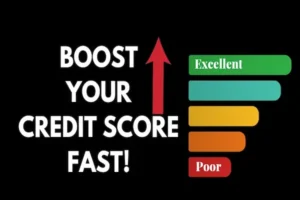How to Improve Credit Score Fast and Quickly
Discover how to improve credit score fast with proven tips, real examples, and step-by-step guidance to take control of your financial future.
Advertising
Why Your Credit Score Is So Important
Your credit score is more than just a number.
It’s your financial reputation that speaks to your reliability.
It affects everything—from getting approved for a loan or credit card to renting an apartment or even applying for a job.
Even car insurance companies and cell phone providers may check your score.
And if your score is low, everything becomes harder, more expensive, and filled with obstacles.
You may end up paying hundreds—or even thousands—more than someone with good credit.
But here’s the good news:
It’s never too late to improve credit score fast.
Even small actions can lead to big changes—if you know what to do and stay consistent.
Understand What Makes Up Your Credit Score
Before you can improve your credit score, you need to know what it’s made of.
Understanding the parts of your score is like learning the rules of the game.
Your credit score is based on five key factors:
- Payment history (35%) – Have you paid your bills on time?
- Amounts owed (30%) – How much of your available credit are you using?
- Length of credit history (15%) – How long have you had credit?
- New credit (10%) – Have you applied for credit recently?
- Types of credit used (10%) – Do you have a mix of credit (cards, loans, etc.)?
Focus most on payment history and balances owed, as they make up 65% of your score.
Fixing those two areas alone can lead to dramatic results.

Step 1: Always Pay Your Bills On Time
Payment history has the biggest impact on your score.
Even one late payment can hurt you for months.
Late payments stay on your report for up to seven years.
So what can you do?
- Set up calendar reminders for bill due dates.
- Use mobile banking to automate payments.
- Talk to your lender if you know you’ll be late—they may help avoid penalties.
Staying on top of bills tells lenders you’re trustworthy.
And it’s the foundation of every healthy credit profile.
Step 2: Reduce Your Credit Card Balances
The second biggest piece of your score is credit utilization.
That’s how much of your available credit you’re using.
Keeping your utilization under 30%—or ideally under 10%—can dramatically boost your score.
Let’s say your credit limit is $1,000.
Try to keep your balance below $300.
Even paying off just $100 can make a noticeable difference.
Strategies include:
- Paying more than once per month.
- Avoiding large purchases right before your statement closes.
- Using cash or debit until your balance drops.
Lowering your utilization is one of the fastest ways to improve credit score fast.
Step 3: Don’t Close Old Accounts
Age of credit history matters.
The longer you’ve had accounts open, the better it looks on your report.
Closing an old credit card can hurt your score—even if you don’t use it.
If it has no annual fee, keep it open and use it for small purchases every few months.
This keeps it active and contributes positively to your score.
The goal is to maintain your oldest accounts as long as possible.
Step 4: Ask for a Credit Limit Increase (Wisely)
You can instantly reduce your credit utilization by increasing your credit limit.
Let’s say you owe $400 on a card with a $500 limit.
That’s 80% utilization.
But if your limit increases to $1,000, your utilization drops to 40%—without paying a cent.
Here’s how to request it:
- Call customer service or log into your credit card app.
- Ask for a modest increase (like $250 or $500).
- Do NOT request it if you’ve recently missed payments.
Used responsibly, this trick is a powerful credit booster.
Step 5: Dispute Any Errors on Your Credit Report
Credit reports aren’t always accurate.
In fact, studies show that 1 in 5 reports has an error.
Errors like:
- Incorrect balances
- Duplicate accounts
- Accounts that don’t belong to you
You can check your credit report for free:
U.S.: AnnualCreditReport.com (all 3 bureaus)
If you find errors, file a dispute online.
Attach proof, like bank statements or payment confirmations.
Credit bureaus have 30 days to respond.
Fixing a single error can add dozens of points to your score.
Step 6: Use a Secured Credit Card to Build or Rebuild Credit
If you have no credit or bad credit, a secured credit card is your best starting point.
You deposit money upfront, which becomes your credit limit.
Use the card for small purchases and pay it off in full each month.
After several months of positive activity, your score rises—and you may even be offered a traditional credit card.
It’s safe, simple, and effective.
Banks like Capital One, Openbank, and Neon offer solid secured card options.
Step 7: Avoid Too Many Credit Applications
Every time you apply for a loan or card, a hard inquiry hits your report.
One isn’t a problem.
But several in a short period can lower your score.
Avoid applying for multiple accounts unless absolutely necessary.
Space out your applications by at least 3 to 6 months.
And always check if a lender uses a soft pull before applying.
Step 8: Become an Authorized User on Someone Else’s Account
If you know someone with great credit, ask to be added to their credit card.
This allows their good history to reflect on your report.
You don’t need to use their card or even hold it.
Just being listed as an authorized user helps you gain credit age and better payment history.
Make sure:
- The account is in good standing
- The balance is low
- The issuer reports authorized users
This method works fast—often within 30 to 60 days.
Step 9: Use a Credit Builder Loan
These loans are small, safe tools offered by credit unions and fintechs.
The loan amount is held in a savings account while you make fixed payments.
At the end, you get the money—and a stronger credit report.
It builds positive history without risking traditional debt.
Apps like Self and Kovo are popular in this space.
Step 10: Track Your Progress Monthly
Seeing your progress keeps you motivated.
Apps like Credit Karma, ClearScore, and Serasa help you monitor changes for free.
Track your credit score once a month—not daily.
Celebrate small improvements.
Even a 10-point increase is a win.
Progress builds confidence—and habits.
Step 11: Budget Smart to Avoid Missed Payments
A missed payment isn’t always about money—it’s about planning.
Use budgeting apps like Mobills or YNAB to organize your bills.
Or use a basic spreadsheet with due dates and amounts.
Include:
- Credit cards
- Loans
- Phone and utility bills
Avoid surprises by staying organized.
Good habits = good credit.
Step 12: Pay More Than the Minimum Due
Minimum payments keep your account current—but they don’t lower your debt fast.
If you can, always pay more than the minimum.
Even $20 extra helps lower your balance and improves utilization.
Paying in full? Even better.
Avoid interest charges and show lenders you manage debt responsibly.
Step 13: Use Extra Cash Wisely
Got a bonus, gift, or refund?
Use it to knock down your highest-interest debt.
This gives your score a boost while saving you money long-term.
Small windfalls can make a big difference if used smartly.
Step 14: Understand and Defend Your Rights
If collectors threaten you or if you feel your report is inaccurate, speak up.
You have the right to:
- Dispute any item
- Request debt validation
- Be treated respectfully
In the U.S., contact CFPB.
In Brazil, use Procon or Reclame Aqui.
Your rights are part of your financial toolkit.
Step 15: Teach Credit Education at Home
Credit isn’t taught in school—but it should be.
Talk to your kids about credit early.
Explain what it is, how it works, and why it matters.
This prepares the next generation for a smarter financial future.
Step 16: Understand What Hurts Your Score
Knowing what not to do is just as important.
Avoid:
- Maxing out your credit cards
- Letting accounts go to collections
- Ignoring due dates
Every negative mark slows your progress.
Prevention is better than cure.
Improve Credit Score Fast—And Stay There
Improving your credit score isn’t just a one-time victory.
It’s a journey.
And once you manage to improve it, the next challenge is to maintain it—and that’s where many people slip.
Because building is hard—but staying consistent is even harder.
But here’s the truth:
Once you understand how credit works, and once you’ve put in the effort to climb out of a low score, you’ll never want to go back.
That’s why creating solid habits matters more than quick fixes.
Don’t fall back into old patterns.
Keep paying bills on time—even if it’s just the minimum.
Keep your credit usage low—even if you get a higher limit.
Check your score once a month—even if everything seems fine.
And remember: good credit is freedom.
It’s the freedom to finance your dreams, take care of your family, and live with dignity.
So protect it.
Celebrate your progress.
Be proud of how far you’ve come.
And keep building the life you deserve—step by step, payment by payment, decision by decision.
Because when you respect your credit, your credit will respect you back.
And that’s the power of staying ready—not just getting ready.





